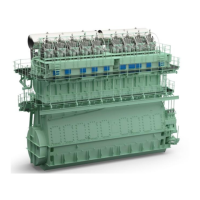Operation
7218−2/A1
Winterthur Gas & Diesel Ltd.
1/ 2
Measurement of Cylinder Lubricating Oil Consumption
1. Calculate the Cylinder Lubricating Oil Consumption
You can measure the cylinder lubricating oil consumption at all engine power outputs.
The engine has a load-related cylinder lubricating system. To get a correct result,
make sure that the engine speed and power are kept as constant as possible.
The cylinder lubricating system has a measurement tube, which has a scale that
gives accurate measurement of the lubricating oil consumption in a short time.
For data about the measurement procedure see 7218−1 paragraph 3.3.
1.1 Calculate the Specific Cylinder Lubricating Oil Consumption
To calculate the specific cylinder lubricating oil consumption, you must know the
power output during the test. Get the engine output:
1) From the curve fuel injection quantity (%) x engine speed (FQ x rpm). Make sure
that the curve refers to the fuel that is used (see the acceptance protocol).
2) From the field Est. Power (%) shown in the operator interface fuel injection
quantity (%) x engine speed (FuelCmd x n).
Equation 1: Specific Cylinder Lubricating Oil Consumption
Specific cylinder lubricating oil consumption =
1000 x G
P
g/kWh [g/BHPh]
G = Cylinder lubricating oil consumption in kg/h
P = Effective engine power output in kW [BHP] derived from curve FQ x rpm
2. Calculate the Theoretical Cylinder Lubricating Oil
Consumption
The specified theoretical supply rate is set in the WECS-9520. To change the
parameters, use the Operator Interface (see 4002-3, paragraph 1.1).
Use Equation 2 to calculate the cylinder lubricating oil consumption (kg/h):
Equation 2: Specified Theoretical Cylinder Lubricating Oil Feed Rate
G =
3600 x V x ò x Z
t
G = Specified theoretical supply rate
V = Supply volume of the lubricating oil pump for each injection pulse [ml]
ò = Oil density [kg/l] (typical value 0.92 kg/l)
Z = Number of injection pulses
T = Measurement time [s].
2014

